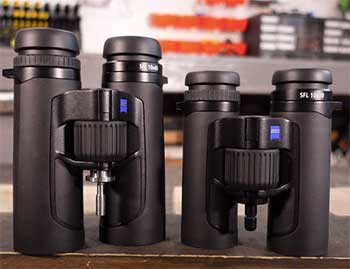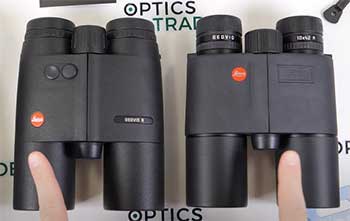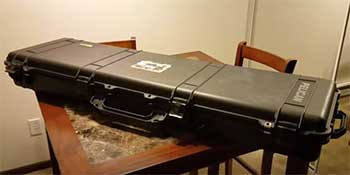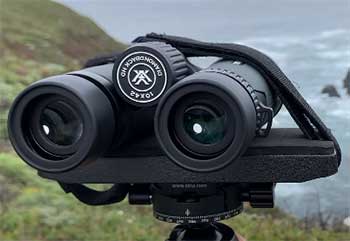Leica and Zeiss are two of the most respected names in optics. Both companies make high-end binoculars optimized for activities like birding, hunting, sports, and theater going. But which brand is right for you?
In this guide, we’ll compare Leica and Zeiss binocular specifics and highlight the pros and cons of each. Read on to learn which excels for your needs and budget.
A Brief Comparison Table
| Feature | Leica Binoculars | Zeiss Binoculars |
| Optical Quality | Superb clarity, color, brightness | Superb clarity, brightness, contrast |
| Housing Material | Magnesium alloy | Polycarbonate or magnesium |
| Weight | 26-43 oz | 16-47 oz |
| Model Selection | Limited, focused on birding/hunting | Diverse, wide range |
| Starting Price | $1300+ | $1000+ |
| Warranty | Lifetime Limited | 5 years |
| Close Focus Distance | ~6 feet | ~8 feet |
| Eye Relief | 16-20mm | 16-20mm |
Leica Binoculars Overview

Founded in 1849, Leica is a German company best known for precision-engineered 35mm cameras.
They also manufacture high-end sport optics like binoculars, spotting scopes, and rangefinders.
Leica binoculars emphasize optical excellence.
They use premium Schott glass and innovative lens coatings for incredible resolution and light transmission.
The result is a bright, crisp image across the entire field of view.
Leica Binoculars Pros
- Exceptional optics with precise color rendition
- Durable construction from quality materials
- Intuitive focusing knob with precise adjustments
- Wide temperature tolerance from -4°F to 158°F
Leica Binoculars Cons
- Very expensive, often over $2000
- Relatively heavy compared to other brands
- Limited model selection
Best For: Demanding users who prioritize optical quality over cost and weight. Excellent for nature observation where fine details make a difference.
Zeiss Binoculars Overview
Carl Zeiss is another prestigious German brand founded in 1846. Like Leica, they are recognized leaders in camera lenses and optical equipment.
Zeiss binoculars use premium SCHOTT glass and cutting-edge coatings. The emphasis is on maximum light transmission for bright, high-contrast images. Zeiss models also have excellent edge-to-edge sharpness.
Zeiss Binoculars Pros
- Amazing clarity and light transmission
- Precisely engineered mechanics
- Robust polycarbonate housing
- Wide temperature tolerance
Zeiss Binoculars Cons
- Very expensive, often over $1000
- Some models are quite heavy
- Limited warranty period
Best For: Demanding users prioritizing optical quality over cost and weight. Excellent for nature observation.
Leica And Zeiss Binoculars Comparison
Now that we’ve covered the basics, let’s compare Leica and Zeiss models head to head:
- Optical Quality
Leica and Zeiss both produce binoculars with incredible optical quality. Users report amazing clarity, color rendition, low distortion, and brightness across the product ranges.
Most models use premium SCHOTT glass and high-tech lens coatings. These minimize reflections and maximize light transmission through the system.
For pure optical performance, Leica and Zeiss are too close to call. It comes down to splitting hairs. Overall image quality depends more on your chosen model than the brand name.
- Durability

Leica binoculars use robust construction and weatherproof O-ring seals.
Their housing is made from lightweight magnesium alloy.
Meanwhile, Zeiss often uses durable polycarbonate housing.
High-end Victory models boast a magnesium housing.
In real-world use, both brands offer excellent durability and water resistance.
For outright robustness, Leica may have a slight edge. But Zeiss also holds up very well over years of hard use.
- Weight
Weight is an important consideration for binoculars used over long periods. Lighter models cause less fatigue when worn on a neck strap.
Most Leica binoculars weigh between 26 and 43 oz. Zeiss models range from about 16 oz for compact porro prism models, up to 47 oz for high magnification and wide objective lenses.
So in general, Leica binoculars tend to be heavier than similarly specced Zeiss models. However, weight depends more on the product line and magnification power.
- Model Selection
One Zeiss advantage is their diverse binocular catalog. It covers a wide range of magnification powers, objective lens sizes, prism types, and body styles.
Leica has a narrower selection focused on a few premium birding and hunting configurations.
So Zeiss gives you more choice to select the right balance of size, power, and price for your application. Leica focuses on perfecting a handful of high-end configurations popular with nature enthusiasts.
- Price
Pricewise, Leica and Zeiss binoculars both fall in the “very expensive” category. Entry-level models start around $1000, while high-end configurations run upwards of $2500.
Interestingly, Zeiss binoculars are often a little more affordable than comparable Leica models. However, both remain luxury purchases reserved for serious optics users.
For most buyers, more affordable brands like Vortex, Nikon, and Celestron offer excellent performance at saner prices.
- Close Focus Distance
The close focus distance is the nearest an object can be while staying in focus. Short close focusing lets you view small nearby objects clearly.
Leica binoculars often have shorter close focus distances around 6 feet compared to Zeiss models. This gives Leica an edge for viewing butterflies, lizards, flowers, and more at close range.
- Eye Relief

Eye relief dictates the distance your eyes can be from the eyepiece while still providing a full viewing field.
Long eye relief is essential for eyeglass wearers.
Both brands offer generous 16 to 20mm of eye relief on most configurations.
This provides a full field of view for spectacle wearers.
- Warranty
Leica offers a Lifetime Limited Warranty on materials and workmanship defects.
In contrast, Zeiss binocular warranties are just 5 years for consumer models.
So for long-term ownership, Leica provides more coverage should an issue arise down the road.
Leica Or Zeiss Binocular: Which Should You Choose?
So when comparing Leica vs Zeiss, which brand has the edge? Here are our recommendations based on budget and intended use:
- For no-compromise optical performance, either brand delivers outstanding quality. Go with whichever model offers the magnification power, objective size, weight, and controls you prefer.
- If low weight is critical, Zeiss is a better choice overall. Though check individual specs, as a few high-end Leica models rival Zeiss’ lightest bins.
- On a tight budget under $1000, Zeiss offers some reasonably priced porro prism bins. Leica starts around $1300 even for compact models.
- For diversity of options, Zeiss provides many sizes and configurations to choose from. Leica has a refined selection focused on premium birding and hunting bins.
- For warranty coverage, Leica’s Lifetime Limited Warranty provides more long-term peace of mind.
Also Read: Comparison of Vortex Copperhead And Crossfire Binoculars.
Frequently Asked Questions (FAQ)
Leica and Zeiss are extremely close in terms of optical quality and workmanship. Both make outstanding binoculars. Leica has a reputation for slightly better quality control and robustness. But for most buyers, differences are minimal and come down to personal preference.
Zeiss produces some of the finest binoculars money can buy. Their optical and mechanical quality is outstanding. However, Leica and other brands like Swarovski also make superb high-end binoculars. For most buyers, any quality bin from Zeiss, Leica, Swarovski, or Vortex will provide excellent performance and lasting value.
The Leica Noctivid and Zeiss Victory are both companies’ top-tier binocular lines. Differences include:
1. Noctivids have a open-bridge design while Victory has a central hinge
2. Noctivids come in 8×42 and 10×42 sizes. Victory offers 8×32, 8×42, 10×42 and 10×54 models
3. Victory SF models have field-flattening lenses for edge-to-edge sharpness
4. Noctivids boast 6.5 feet close focus vs 8.2 feet for Victory
5. Noctivid housing and armor is magnesium vs Victory’s polymer/aluminum
6. Noctivid weights are 25-28oz vs 27-47oz for Victory
7. Victory costs $1600-$2500 while Noctivid runs $2300-$2800
For most users, both provide outstanding quality. Shoppers should choose based on preferred configuration, weight, and budget.
Zeiss and Swarovski are close competitors both renowned for amazing optical quality. In terms of performance, they are too close to call, with both producing superb bright, crisp viewing.
Differences come down to model selection, styling preference, weight, and budget. But optically they perform at a similarly lofty level. You can’t go wrong with either brand for a once-in-a-lifetime binocular purchase.
Final Thoughts
Both brands make exceptional binoculars aimed at discerning users. While technical differences exist, real-world performance is outstanding across the board. Choosing comes down to your budget, size needs, and personal preferences.
Whichever you select, proper care goes a long way to maximize their lifespan. Always store high-end bins in their case when not in use. Clean the exterior lenses gently with optic wipes and air puffers. Avoid touching glass surfaces to prevent oils and dirt buildup.

